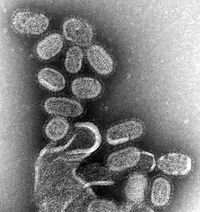
Photo from wikipedia
Asthma is a heterogeneous disease with varying severity and subtypes. Recent reviews of epidemiologic studies have identified cleaning and disinfecting activities (CDAs) as important risk factors for asthma-related outcomes among… Click to show full abstract
Asthma is a heterogeneous disease with varying severity and subtypes. Recent reviews of epidemiologic studies have identified cleaning and disinfecting activities (CDAs) as important risk factors for asthma-related outcomes among healthcare workers. However, the complexity of CDAs in healthcare settings has rarely been examined. This study utilized a complex survey dataset and data reduction approaches to identify and group healthcare workers with similar patterns of asthma symptoms, and then explored their associations with groups of participants with similar patterns of CDAs. Self-reported information on asthma symptoms/care, CDAs, demographics, smoking status, allergic status, and other characteristics were collected from 2030 healthcare workers within nine selected occupations in New York City. Hierarchical clustering was conducted to systematically group participants based on similarity of patterns of the 27 asthma symptom/care variables, and 14 product applications during CDAs, separately. Word clouds were used to visualize the complex information on the resulting clusters. The associations of asthma health clusters (HCs) with exposure clusters (ECs) were evaluated using multinomial logistic regression. Five HCs were identified (HC-1 to HC-5), labelled based on predominant features as: "no symptoms", "winter cough/phlegm", "mild asthma symptoms", "undiagnosed/untreated asthma", and "asthma attacks/exacerbations". For CDAs, five ECs were identified (EC-1 to EC-5), labelled as: "no products", "housekeeping/chlorine", "patient care", "general cleaning/laboratory", and "disinfection products". Using HC-1 and EC-1 as the reference groups, EC-2 was associated with HC-4 (odds ratio (OR) = 3.11, 95% confidence interval (95% CI) = 1.46-6.63) and HC-5 (OR = 2.71, 95% CI = 1.25-5.86). EC-3 was associated with HC-5 (OR = 2.34, 95% CI = 1.16-4.72). EC-4 was associated with HC-5 (OR = 2.35, 95% CI = 1.07-5.13). EC-5 was associated with HC-3 (OR = 1.81, 95% CI = 1.09-2.99) and HC-4 (OR = 3.42, 95% CI = 1.24-9.39). Various combinations of product applications like using alcohols, bleach, high-level disinfectants, and enzymes to disinfect instruments and clean surfaces captured by the ECs were identified as risk factors for the different asthma symptoms clusters, indicating that prevention efforts may require targeting multiple products. The associations of HCs with EC can be used to better inform prevention strategies and treatment options to avoid disease progression. This study demonstrated hierarchical clustering and word clouds were useful techniques for analyzing and visualizing a complex dataset with a large number of potentially correlated variables to generate practical information that can inform prevention activities.
Journal Title: International journal of hygiene and environmental health
Year Published: 2019
Link to full text (if available)
Share on Social Media: Sign Up to like & get
recommendations!